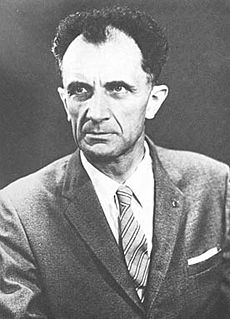Adolf Busemann facts for kids
Quick facts for kids
Adolf Busemann
|
|
|---|---|

Adolf Busemann at Langley
|
|
| Born | 20 April 1901 |
| Died | 3 November 1986 (aged 85) |
| Nationality | German |
| Alma mater | Technical University of Braunschweig |
| Awards | Ludwig Prandtl Ring (1966) |
| Scientific career | |
| Fields | Aerospace engineering |
| Institutions | University of Colorado at Boulder |
| Doctoral advisor | Otto Föppl |
| Doctoral students | Nguyễn Xuân Vinh |
Adolf Busemann (born April 20, 1901 – died November 3, 1986) was a German aerospace engineer. He was a very important scientist in the field of aerodynamics. This is the study of how air moves around objects, especially planes.
Busemann was a pioneer in understanding how air flows at very high speeds, called supersonic airflows. He came up with the idea of swept wings for aircraft. These are wings that angle backward instead of being straight. Later, he moved to the United States in 1947. This happened as part of a program called Operation Paperclip. In the U.S., he invented the Busemann biplane. This special plane design was meant to fly at supersonic speeds without creating shockwaves.
Contents
Early Life and School
Adolf Busemann was born in Lübeck, Germany. He went to the Technical University of Braunschweig. In 1924, he earned his Ph.D. in engineering.
Career and Discoveries
In 1925, Busemann started working as an aeronautical research scientist. He joined the famous team at the Max-Planck Institute. This team included other well-known scientists like Ludwig Prandtl.
In 1930, he became a professor at the University of Göttingen. During this time, he held several important roles in German science. During World War II, he directed the Braunschweig Laboratory. This was a famous research center.
The Swept Wing Idea
Busemann made a big discovery about swept wings. He found that angling airplane wings backward helped planes fly better at high speeds. He first shared this idea at a conference in Rome in 1935. At that time, planes didn't fly much faster than 300 miles per hour. So, his idea seemed like just a theory.
However, he kept working on it. By the end of 1935, he showed that swept wings also helped planes in the transonic region. This is the speed range just below and above the speed of sound. As director of the Braunschweig labs, he began testing his ideas in a wind tunnel. By 1942, he had collected a lot of useful information. Germany then started developing the Messerschmitt Me P.1101. This plane was designed to test Busemann's swept wing ideas in flight.
Impact on Aircraft Design
After World War II ended, American scientists visited Germany. They were part of Operation Lusty. This team included famous names like Theodore von Kármán. They found a lot of data on swept wings at the Braunschweig labs. When they asked Busemann about it, he reminded them of his 1935 presentation.
Many of the American scientists remembered the presentation. However, they had forgotten how important the details were. One scientist, George S. Schairer from Boeing, quickly realized its value. He told Boeing to study the idea. This led to the B-47 Stratojet being redesigned with swept wings. Busemann's work, along with similar research by Robert T. Jones in the U.S., changed how airplanes were designed forever.
Later Research
Near the end of the war, Busemann also studied delta wings. These are wings shaped like a triangle. His work helped create his supersonic conical flow theory. This theory made it easier to understand how air flows around delta wings. It was used in the aircraft industry for some time.
In 1947, Busemann moved to the United States. He started working at NACA's Langley Research Center. In 1951, he gave a talk about how air behaves at near-supersonic speeds. He explained that air acts like "streampipes" that don't change much in size. He joked that aerodynamicists needed to become "pipe fitters." This talk inspired another scientist, Richard Whitcomb, to develop the Whitcomb area rule. This rule helps reduce drag on planes flying at high speeds.
At Langley, Busemann mainly worked on sonic booms. These are loud noises created by objects moving faster than sound. He tried to understand and find ways to get rid of them. He also invented the Busemann Biplane. This design, first proposed in 1936, was unique. It was meant to fly supersonically without creating shock waves or wave drag. However, it also didn't produce any lift, which is needed to keep a plane in the air.
Busemann also did early work on magneto-hydrodynamics in the 1920s. This field studies how electrically conducting fluids interact with magnetic fields. He also researched how shock waves could be focused and how gases behave when they are not steady.
From 1963, Busemann was a professor at the University of Colorado. He suggested using ceramic tiles on the Space Shuttle. NASA later adopted this idea.
Awards and Recognition
In 1966, Adolf Busemann received the Ludwig-Prandtl-Ring. This award is given by the German Society for Aeronautics and Astronautics. It recognized his "outstanding contribution in the field of aerospace engineering." He passed away at age 85 in Boulder, Colorado.

